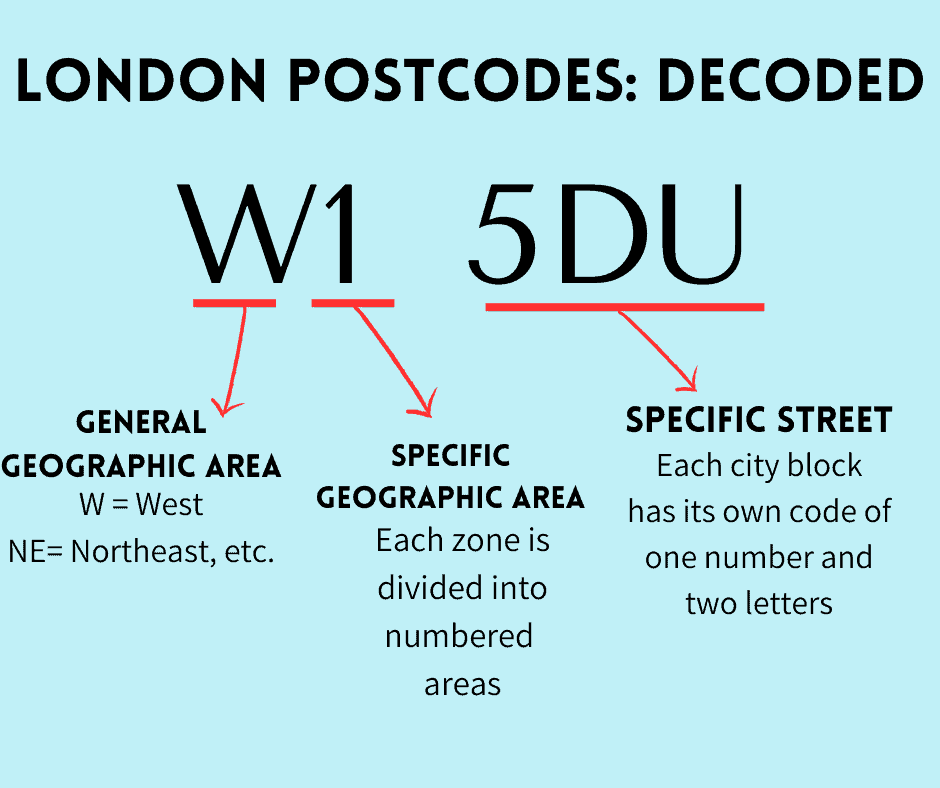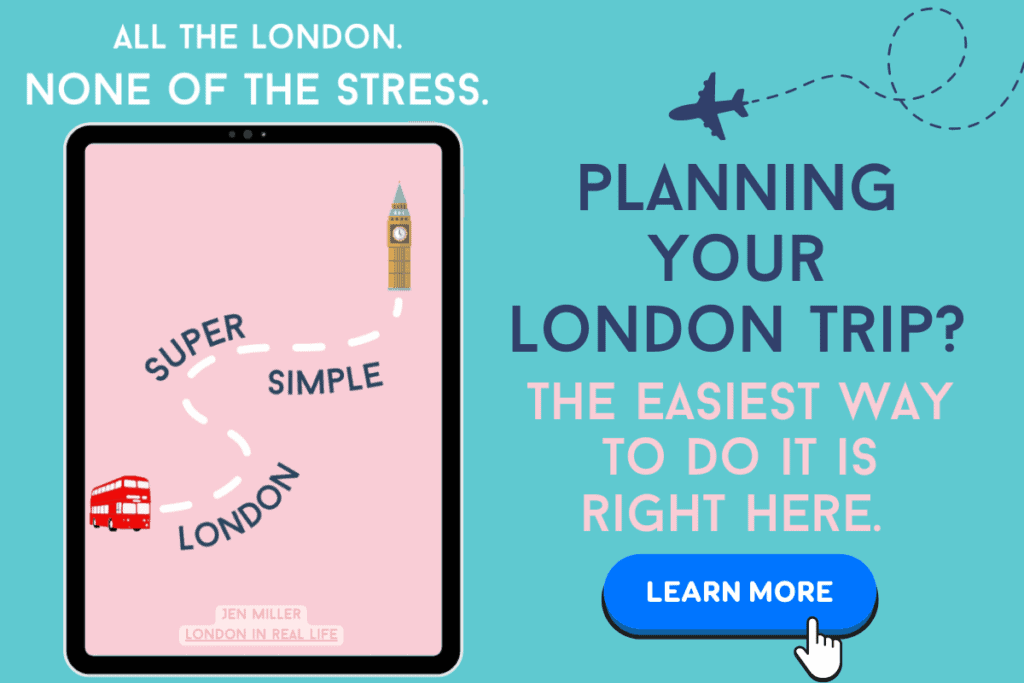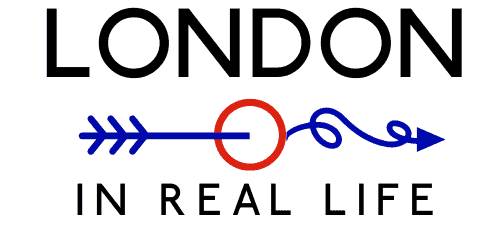Decoding London Postcodes, The Easy Way
Trying to figure out a London zip code for travel or mail? You won’t find it.
Zip codes are uniquely American, and London uses postcodes.
These look very different from the American 5-digit numeric codes, and they’re confusing for foreigners at first. When I first moved to London from America, I had no idea what I was looking at.
But they’re easy to learn, and I’ll teach you. Here’s how to interpret a London postcode and use them correctly.
Jump To:
What Are Postcodes in London?

In London and the UK, the postcode is the last part of the address, right after the city. For example: W1-5DT.
A London postcode, unlike American zip codes or Indian pin codes, are alphanumeric, meaning they contain both letters and numbers. These codes are used to identify specific blocks in London.
In the United States these are called Zip Codes, in India these are called Pincodes, and other countries have their own names for them.
What’s the London Postcode?

There’s not just one London postcode. Every single street in London has a different postcode.
This city is massive, so postcodes for every address are divided into number and letter codes.
Each city block has its own postcode (and sometimes more than one).
How to Read a London Postcode

A typical London postcode looks like this: W1-5DU.
It consists of two parts: the outward code and the inward code. The outward code is the general geographic area and specific geographic area.
The last part of the code (inward code) – the last 3 numbers and letters – signify a specific city block.
First Letter: General Area

The first part of the London post code, the outward code, starts with one or two letters. This identifies the general area (in this case, W stands for West London).
- N or NW= North London
- E= East London
- W= West London
- S, SE, or SW= South London
- EC or WC= Central London
- Other outward codes not starting with these letters are unique to areas in Greater London.
First Number: Geographic Region

A 1 or 2 digit number follows the letter (in this case, the number 1).
Each geographic area (West, or North, etc.) is subdivided into numbered regions.
West London will be divided into W1, W2, W3, and so on.
Areas in Northwest London start with NW: NW1, NW2, or NW3, and so on.
Does the number mean anything? Yes, and it’s not only good for delivering mail.
Typically, the number 1 will be closest to the center of London, and the biggest numbers, like N20, will be the farthest away from the city center.
So if you’re in N1 and the place you want to go is in N20, it’s going to be far away. This is a quick and easy way to understand how far away something is – just by looking at the number code.
Inward Code: Specific Block

The second part of the code – the inward code – is made up of one number and two letters, which identify the specific city block (in this case, 5DU).
Each side of a city block has its own inward code, so there may be 15 homes that all have the same exact postcode, because they are all on the same side of the city block with that same inward code.

For example, a postcode in North London might look like: N15-5FR. One whole side of the block will have that postcode.
A postcode in Southeast London might look like this: SE4-6JW, and that code will apply to each building on the whole block.
Since homes share the same postcode, the only way you’ll know which house on the block you need is by knowing the street address.

Do these outward codes mean anything? Not particularly. They’re really more of a way for mail and deliveries to reach the right place.
You can’t tell much of anything about a place by looking at its outward code.
It’s the inward code – the first part of the postcode – that matters most for navigating London.
What is the Central London Post Code?
Central London postcodes are the same as the rest of London: they’re unique to the city block, so there are unlimited combinations. There’s not just one central London postcode.
Generally, a Central London postcode begins with either WC (West Central), EC (East Central), N (North), NW (North West), SE (South East), SW (South West), or W (West).
The central London postcode you need could start with any of these letters, and it’s a wide area.
If you don’t know the postcode, the best way is to look up the street address on Google Maps and see what postcode comes up.
Navigating London, Easily.

Greater London Post Codes
Not all of the postal codes of London are included in North, West, East, and South.
Some areas in Greater London (like London suburbs) have their own geographical signifier.
The central London postcodes are the ones in the very middle of the map that start with N, S, E, and W.
Areas outside of the North, South, East and West London postcodes have their own signifiers.
So a postcode in Twickenham, for example, might look like: TW3-5UB.
The Greater London postcodes are:
- EN (Enfield)
- HA (Harrow)
- IG (Ilford)
- KT (Kingston upon Thames)
- RM (Romford)
- SM (Sutton)
- TW (Twickenham)
- UB (Uxbridge)
- WD (Watford)
What are London Postcodes Used For?
London postcodes are used for several purposes, including:
- Mail Delivery: The most obvious use of a postcode is for mail delivery. Postcodes help to ensure that letters and parcels are delivered to the correct address.
- Navigation: Postcodes can also be used for navigation. If you enter a postcode into a satnav or mapping app, it will take you directly to the correct city block. Of course, you’ll need to know the house or building number to find exactly where you’re going.
- Local Services: Many local services, such as libraries, schools, and hospitals, use postcodes to identify their catchment areas.
Is There a London Zip Code?

There is no London zip code – there are only London postal codes.
In the USA, zip codes start with numbers, and generally cover a very wide area. The signifier of “97” – for example, covers the entire state of Oregon, so all buildings in Oregon have a zip code starting with 97.
In London and the UK, postcodes start with letters and often cover a much smaller area. With London postcodes, the signifier “N” only covers a specific area of North London.
How to Use Postcodes in Daily Life

As a Londoner myself, I find London postal codes to be incredibly useful and practical in my everyday life. They make navigating the city a breeze by providing a clear and organized system to locate specific areas.
The most useful aspect of London postcodes is that they prevent you from traveling to the wrong place. Since London is so big, there are often two streets with the same name, and even two places with the same building number and street name.
But if you plug in the post code and cross check the address, you’ll never go to the wrong place.
Learn Your London Postcodes!
London postal codes can seem confusing at first, but once you understand how they work, they become an essential tool for navigating the city.
By understanding the different areas and codes, you’ll know exactly where you’re going. Your mail will never get lost, you’ll know how far away everything is, and it’ll make navigation a breeze.
FAQ
What is the London Pincode?
In London and the UK we use postcodes, not pincodes. But they serve the same purpose: identifying geographic areas for mail delivery and navigation.
What is a “valid” UK postcode?
A valid UK postcode is in the format I’ve explained above, such as: N1-8DU. If you’re getting the error message “invalid postcode,” sometimes your browser settings or website settings are incorrect.
If you’re shopping online (either in the UK or from a UK retailer) but from another country, check that your settings are ticked to “UK” or “GBP”.
Also, make sure the website you’re shopping in actually ships to the UK. If you still have trouble, contact the retailer.
How do I find my postcode?
There are a number of ways you can find out your postcode. But the easiest way is to find your location on google maps, locate the address, and find the postcode listed next to the city in the address section.
What is a 5 digit postcode in the UK?
Unlike the US, the UK doesn’t use 5 digit zip codes. UK postcodes are alphanumeric, and can have between 5 and 7 letters and numbers.
Are all UK postcodes 7 digits?
No. UK postcodes can have between 5 and 7 letters and numbers.
Is a Zip Code my postcode?
If you’re in the US, yes! It’s the same thing. The US uses 5 digit zip codes instead of postcodes.
More on Navigating London
What’s the Postcode for Europe? (Hint: Every Country is Different)
Ultimate Guide: 49 Brilliant London Apps Everyone Should Know
Top 5 Best and Worst Times to Visit London
31 Exclusive & Unusual Things to Buy in London, and 15 Things to Avoid
How to Catch a Bus in London for the First Time
The 5 Safest London Boroughs (and 2 that are affordable!)
How to Travel in London During a Tube or Rail Strike
The Best Navigation App for London to Download Now
How to Use Google Maps in London







